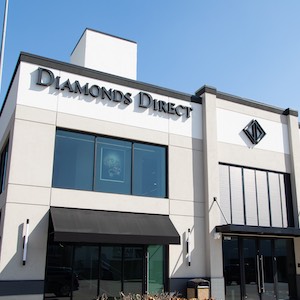
Signet’s comp sales fell 9.1% in the fourth quarter of fiscal 2023 (ended Jan. 23)—as America’s largest jewelry retailer coped with a jittery consumer mood and a drop in engagements.
“Our comps being down is purely the reflection of the challenges in the [jewelry] category, which we’re all seeing with the macroeconomic environment,” Signet CEO Gina Drosos tells JCK, following the March 16 release of its latest financial results.
She says that while last year was “the year of the wedding,” engagements saw a double-digit dip last year and will probably fall again in the year ahead. Drosos expects engagements to “rebound” in Signet’s fiscal 2025 (which would be calendar year 2024).
Overall, Signet expects jewelry sales to be down “mid–single digits” over the next year.
But Drosos notes that despite the challenging environment, Signet still delivered a double-digit operating margin of 10.8%, and it increased its overall share of the jewelry market.
Signet estimates it accounts for 9.7% of U.S. jewelry sales—just shy of the 10% market-share goal it set in 2021.
Drosos says that Signet’s long-term strategy involves “tiering up” its merchandise mix—as the accessible luxury and luxury segments are now among the strongest in the industry.
“Signet has traditionally played a bit more in the mid-market,” Drosos says. “Our average transaction value is up 30% over the past several years as we have leaned into accessory luxury banners like Diamonds Direct, Blue Nile, James Allen, and Jared, and we’ve brought higher-value merchandise into our other banners like Kay and Zales.”
It’s also opening more stores under the Diamonds Direct banner. Signet bought the retailer, which now numbers 26 stores, in 2021.
“We’re doubling the pace of those store openings. Historically, [Diamonds Direct] opened two, maybe three stores in a good year. Our intention is to open five in this year ahead. It’s quite an acceleration. When you think about the fact that the average Diamonds Direct store does over $15 million in sales, that megastore concept is really very valuable.”
Jared is also getting “tiered up,” and its stores are “leaning into services,” particularly the Jared Foundry, its custom-design center.
“We have other ideas about different kinds of events and more luxury experiences and offerings [that] we’re testing in a number of Jareds,” she says.
Signet now has four banners that target the “accessible luxury” segment. But Drosos feels “there’s plenty of market space for all four of those banners.
“Despite being the largest jewelry retailer in the U.S., we still have under 10% market share, so there’s 90% of consumers who we’re not [selling to]. So we really differentiate [those banners] based on their product assortment, based on the services that we offer, based on our jewelry consultants, the consumer relationship marketing that they’re doing, and based on demographics.
“Diamonds Direct, for example, tends to have most of its stores in what I would call strong mid-tier markets, like Charlotte, North Carolina, or San Antonio, Texas. Jared skews more toward the larger markets.”
And while both Blue Nile and James Allen are online diamond marketplaces—which recently consolidated their back-office functions—they draw a different customer, she says. Blue Nile’s core buyer is “younger, more affluent, more diverse, more urban,” she explains. “Those are two distinct brand offerings and banners.”
She notes that while jewelry “traditionally has been one of the more brick-and-mortar-oriented categories,” COVID-19 changed that.
“We know now that two-thirds of our best customers—people who spend more than $500 with us over three years, which in jewelry is not a lot—interact with us first online, even though 80% of our sales are still in-store. And so, connected commerce is really important. Blue Nile and James Allen are the tip of the spear for understanding what it means to be a great digital player.”
Blue Nile, which Signet purchased last year, “contributed to our total growth and performed ahead of sales and profit expectations in its first full quarter as part of our portfolio,” Drosos said on Signet’s earnings call. “It was slightly accretive to the quarter.”
Signet’s sales for the fourth quarter totaled $2.7 billion, down 5.2% from the prior year, but up 23.8% compared with fiscal year 2020.
Overall sales for fiscal year 2023 totaled $7.8 billion—a 0.2% increase in sales over fiscal year 2022, and a 27.8% increase from three years ago (pre-COVID).
Drosos notes that Signet’s balance sheet is extremely healthy, showing $659 million of free cash flow, with $1.2 billion in cash on hand as well as $2.6 billion in overall liquidity.
“This is one of the things I’m proudest of at Signet,” she says. “Our financial health is now so strong that we invest to build our competitive advantages in a great year, as well as in a down year. We can deliver a double-digit operating margin, which is what investors really expect from us, in an up year or in a down year.
“Last year, fiscal 2023, the results were a great proof point of that. Not only did we overcome the war in Ukraine and the macro environment, but also Winter Storm Elliott on three of the biggest shopping days of the year. What I think that really speaks to is the resiliency of our team and our operating model now. We are a very healthy company.”
Photo courtesy of Signet Jewelers
- Subscribe to the JCK News Daily
- Subscribe to the JCK Special Report
- Follow JCK on Instagram: @jckmagazine
- Follow JCK on X: @jckmagazine
- Follow JCK on Facebook: @jckmagazine





